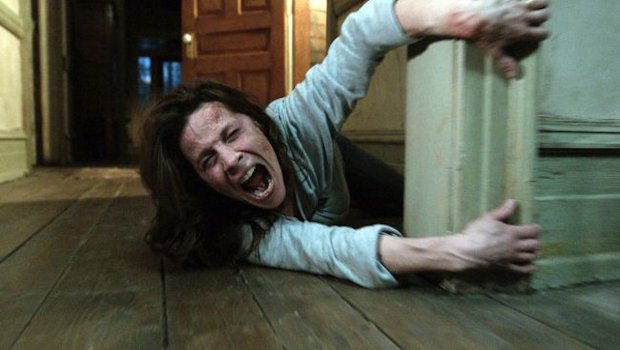I am always wary of a film that proclaims itself as the most terrifying thing ever, so scary that people faint watching it. I am even more wary of a film that proclaims to be the most terrifying thing ever and be based on a true story. The previews for The Conjuring proclaimed it to be the latter and, of course, I was skeptical.
As I stood in line to buy my ticket, a trio of older women were discussing the film and stated that a friend of theirs had left the theater, went home, and took down two glasses of whiskey. They asked me what I was going to see and proclaimed me quite brave for venturing to the film alone. I haven’t seen this cultural zeitgeist about a horror film since the original Paranormal Activity was released five years ago, and considering my thoughts on that film, I was not expecting much from The Conjuring. And maybe, just maybe, that is why it surprised me.
The Conjuring is the latest film from director James Wan (Saw, Insidious), and it centers around the Perron family. After moving into an old house in the middle of nowhere Rhode Island, they experience paranormal occurrences that quickly escalate in intensity. The family calls in renowned paranormal investigators Ed and Lorraine Warren (played by Patrick Wilson and Vera Farmiga) to investigate, and it is quickly determined that a demonic presence has latched itself onto the family. A race against time begins as the Warrens try to help the Perrons escape the clutches of the demon.
There is a common misconception that to be a good horror film you need to be loaded with terrifying scares. Sure, being scary is a staple of good horror, but some of the worst horror films feature some fantastic jump-out-of-your-seat moments of terror. These scares often come via cheap means and (while effective) don’t speak to the overall quality of the film. What good horror films truly need to be successful though is the ability to convey tension on screen and transfer that to the audience. Quality tension manipulates the audience better than any cheap jump scare.
The Conjuring gives glimpses of its horror but never more than a few fleeting seconds here or there. It’s just enough to convey the reality of the horror haunting the house but shows little enough that you never know at what point the terror will leap out.
Conversely, the Perrons look and act how you would expect a real family to act. Roger (Ron Livingston) and Carolyn (Lili Taylor) have real world problems and worry about things like paying their bills while still finding time to have a little fun after the kids go to sleep. The kids interact with each other just like real siblings, playing with each other one moment and throwing each other under the bus the next. These character moments, often left out of horror films in favor of cheap scares, gore or nudity, helped to make me relate to the family.
Together, these components create a perfect atmosphere for building tension, and Wan (much like he did with Insidious) deftly utilizes these components, transferring a realistic sense of unease to the audience,slowly ratcheting that tension up until it is super taught. The problem with The Conjuring, though, is that instead of cutting the tension with a knife and converting that unease into something special, the film allows the tension to unravel limply in the finale. In the end, The Conjuring is just another demonic possession story that predictably culminates in an ending where good defeats evil, and the demon is sent packing.
As a lifelong Stephen King fan, I understand that endings in horror are often hard to make satisfying. Still, there is always a twinge of disappointment when a masterful work in the genre falls flat at the end. Make no mistake: The Conjuring is a masterful piece of horror filmmaking. It is simply missing that final piece to make it transcend its genre and become a truly great film.


